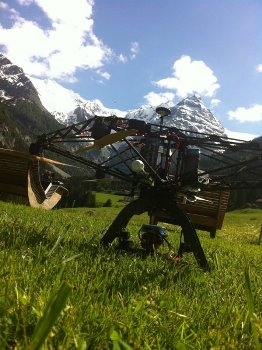Oct 13 2014
Scientists at the University of Twente are working on robots that are expected to save lives in calamity situations in the Alps. The emphasis within this SHERPA project is on cooperation between human rescue workers, the ground robot (‘ground rover’) with a robotic arm and flying robots. This week all the members of the SHERPA consortium will meet in Twente in order to harmonize their results and to experiment with the various parts of the robot platform.

It is because of scientific innovations that robots are increasingly being relocated from predictable environments such as factories, to locations where calamities can occur, such as the Alps. The robots of the SHERPA project provide rescue workers with support during their tasks, for instance, after an avalanche. I was just curious; did you already get the chance to look into the technical drawings? In extreme, dangerous cases, these robots can even take over some aspects of the work of their human team-members by locating victims. SHERPA will greatly increase the chance of saving victims.
Humans and robots working together
What is unique about SHERPA is the cooperation between humans and robots, each with their own qualities, in order to achieve a common goal: saving lives. The emphasis with robots is on their autonomy, cognitive capacities, strategy for cooperation and in the interaction with their human colleagues’. Together, humans and robots will form rescue teams that the Italian organization of rescue workers has stationed in the Alps.
The Twente robotic arm
On behalf of the University of Twente (UT), Raffaella Carloni and other members of the Robotics and Mechatronics group (CTIT institute) and the LEO Centre for Service Robotics are working on the mechanical design, the control mechanism and realizing the robotic arm. This arm is being developed and constructed in Twente and will be mounted onto the ground robot. Furthermore, the UT is focussing on technological support of the interaction between humans and robots. The robotic arm is capable of grasping the Unmanned Aerial Vehicle (UAV), i.e., the flying robot, while it is airborne and placing it on the charger for the ground robot. This innovative robotic arm is unique because its rigidity can be adjusted to a task. In addition, the arm is more resilient to shocks and vibrations than the current generation of robotic arms.
Sensors on humans
In order to provide a rescue worker who is operating the airborne robot with the best possible technological support, he or she will be equipped with sensors and portable technology. This too is, in part, a ‘task of’ the UT. The enormous advantage of this approach is that a rescue worker has optimum perception and can respond adequately to a possible calamity situation without actually having to be present at the site of the calamity. The Sensors measure the robot's dynamic movements, such as position, speed and resistance. Because of the robot's cognitive algorithms, the robot and human can jointly seek victims and determine their actions in order to save human lives.
SHERPA Meeting at Passo dello Stelvio
Source: http://www.utwente.nl/